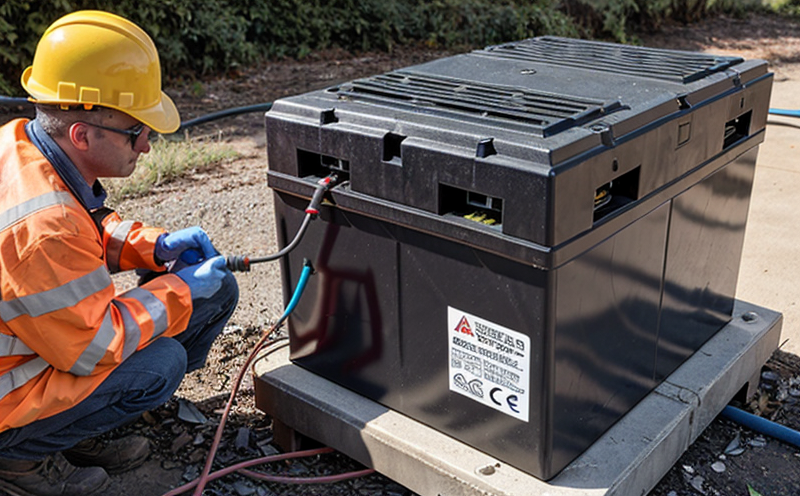IEEE 1188 VRLA Lead-Acid Battery Testing in Stationary Applications
The IEEE Standard Standard Test Method for Stationary VRLA (Valve Regulated Lead Acid) Batteries, IEEE 1188, is one of the most critical standards guiding the testing and performance evaluation of valve regulated lead-acid batteries used in stationary applications. These applications include uninterruptible power supplies (UPS), renewable energy storage systems, backup power systems for telecommunications infrastructure, and more.
VRLA batteries are widely used due to their maintenance-free nature and reliable performance over a wide range of environmental conditions. The standard provides a comprehensive set of guidelines for testing the electrical characteristics, mechanical integrity, and safety features of these batteries under various controlled laboratory settings. Understanding the scope of IEEE 1188 helps us appreciate its importance in ensuring consistent quality and reliability.
Stationary VRLA batteries are designed to provide power without moving parts or gas release mechanisms that could compromise containment during charging, discharging, or cycling. This makes them suitable for environments where space is limited, such as data centers or telecommunications hubs. The IEEE 1188 standard ensures that these batteries meet stringent performance criteria before deployment.
The testing procedures outlined in IEEE 1188 cover a multitude of parameters including open circuit voltage (OCV), short-circuit current (ISC), internal resistance, capacity retention, and more. These tests are conducted under controlled conditions to simulate real-world operating environments accurately. Compliance with these standards is crucial for ensuring the longevity and reliability of battery systems in critical applications.
Given the complexity and importance of stationary VRLA batteries, compliance testing must be precise and repeatable. The standard provides detailed methodologies that laboratories can follow to ensure consistent results across different batches or models of batteries. This precision is particularly important when selecting batteries for sensitive applications like UPS systems where any failure could lead to significant downtime.
The IEEE 1188 standard also emphasizes the importance of environmental factors in testing VRLA batteries. Factors such as temperature, humidity, and altitude can significantly impact battery performance. By conducting tests under these varying conditions, manufacturers and users can better understand how each variable affects overall battery health and lifespan.
For quality managers and compliance officers responsible for ensuring adherence to industry standards, IEEE 1188 offers a robust framework. It helps in identifying potential issues early on, thereby preventing costly failures down the line. This proactive approach ensures that only high-quality batteries are used in critical applications, enhancing overall reliability.
From an R&D perspective, compliance with this standard facilitates innovation by providing a benchmark against which new designs can be evaluated. Engineers working on improving battery technology can use IEEE 1188 as a reference point to ensure their prototypes meet established performance metrics before proceeding further in development cycles.
Why It Matters
The reliability of stationary VRLA batteries is paramount for critical infrastructure. Any failure could result in significant operational disruptions, especially in sectors like telecommunications and data centers where uninterrupted power supply is essential. Ensuring that these batteries meet the stringent requirements specified by IEEE 1188 helps mitigate such risks.
- Reduces Downtime: Reliable testing ensures that only robust batteries are deployed, reducing the likelihood of unexpected failures during critical operations.
- Increases Safety: By adhering to stringent safety protocols outlined in IEEE 1188, potential hazards associated with improper battery function are minimized.
- Sustains Performance: Regular and thorough testing helps maintain optimal performance over the lifespan of the batteries, extending their useful life significantly.
The importance of compliance cannot be overstated in ensuring that infrastructure remains operational at all times. This not only enhances business continuity but also contributes to overall economic stability by preventing costly downtime and service interruptions.
Environmental and Sustainability Contributions
Battery testing under the IEEE 1188 standard plays a crucial role in fostering environmental sustainability, particularly within stationary applications. By ensuring that batteries are reliable and long-lasting, we can reduce waste associated with frequent replacements or premature failures.
The standard promotes efficient use of resources by encouraging manufacturers to design products that meet stringent performance standards right from the start. This reduces the need for excessive material usage in manufacturing processes, contributing positively towards resource conservation efforts.
In addition to reducing waste generation, adherence to IEEE 1188 also supports sustainable practices through proper disposal methods once batteries reach end-of-life stages. Proper recycling ensures that valuable materials are recovered and reused rather than discarded as hazardous waste.
The testing procedures outlined in IEEE 1188 help identify any inefficiencies or areas for improvement, promoting continuous improvements in product design and manufacturing processes. Over time, these advancements contribute to creating more efficient and sustainable battery technologies.
Moreover, compliance with this standard fosters a culture of responsibility among manufacturers and users alike. By prioritizing reliability and safety, we encourage responsible practices that benefit both present and future generations. This collective effort contributes significantly towards achieving broader goals related to environmental sustainability.
Frequently Asked Questions
Competitive Advantage and Market Impact
- Innovation Leadership: Compliance with IEEE 1188 encourages continuous improvement in battery design, leading to competitive advantages through superior product offerings.
- Premium Brand Perception: Adherence to this standard enhances brand reputation by demonstrating a commitment to quality and reliability.
- Market Access: Meeting these stringent requirements opens doors to international markets where compliance is mandatory for certain applications.
The ability to demonstrate conformance with IEEE 1188 can significantly enhance market competitiveness. It signals to potential clients that the supplier adheres to high standards, which is particularly valuable in highly regulated industries. This certification also facilitates easier entry into global markets where specific regulatory requirements apply.





